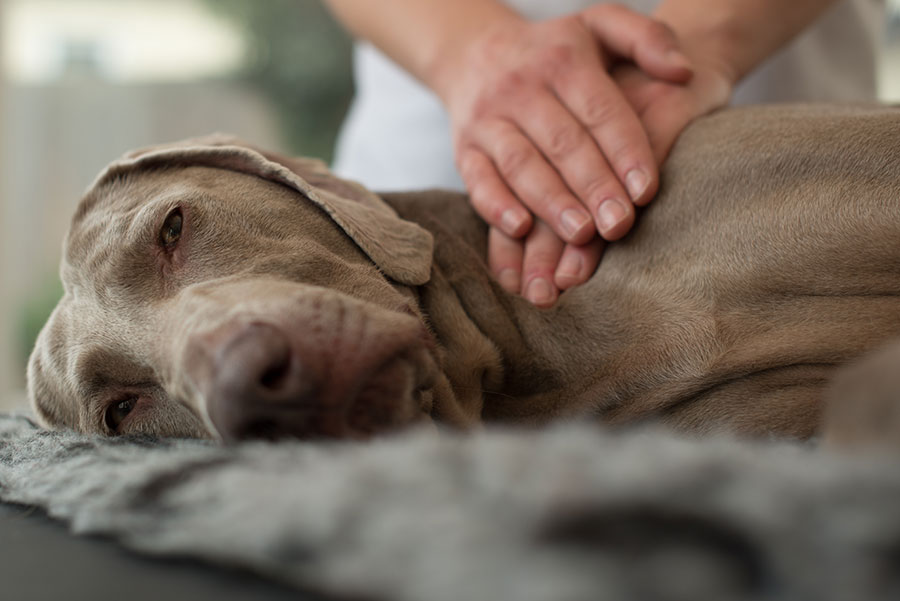What is Canine Massage?
Clinical Canine Massage, typically known as Canine Massage or Canine Massage Therapy, is a natural way to restore, maintain & enhance your dogs overall wellbeing. As well as aiding recovery, recuperation & rehabilitation, Canine Massage is an effective preventative measure at all stages of your dog’s life. By working closely with vets, physios and other therapists in a multimodal approach we can achieve the best possible results for the welfare of the dogs we treat.
Dog’s have approximately 700 muscles that pull on over 300 bones and a network of connective tissue (fascia), tendons & ligaments that produce movement. Canine Massage provides natural pain relief maintaining the entire body & physical condition by targeting the musculoskeletal, blood circulatory, lymphatic & nervous systems. It influences the body’s natural healing process by encouraging fresh blood, nutrients, increasing oxygen and lymph flow around the body, and removal of waste products such as lactic acid and toxins.
Massage is said to be the oldest form of healing known to man, documented as far back as 2700 B.C
Canine Massage is not and does not replace any veterinary care; it works in conjunction with your veterinarian to offer your dog the ultimate in health care.
What happens in a treatment?
Before the first therapy session, a consultation with the owner, carer or person responsible for the dog will determine the reason canine massage therapy is sought.
A vital part of the treatment happens before touching the dog. Reading the dog’s body language and responding appropriately is an essential component in Canine Massage to develop a better understanding of how to approach & work with your dog.
The first session will consist of me getting to know both your dog and yourself, questions regarding your dog’s medical history/conditions, activities of daily living, exercise, diet, medication & supplements.
• Gait analysis – movement pattern to assess areas of pain/stiffness, and in subsequent treatments to observe improvements/changes
• Posture analysis – observing how your dog holds its body
• Palpation – full body examination of muscles to help identify areas of tenderness, tension muscle atrophy, identify any trigger points (knots) and overcompensation
• A full body massage on your dog, to include Swedish, Sports, Deep Tissue, Myofascial release and the Lenton Method, encompassing over 50 techniques. Each session is tailored to suit your individual dogs needs in order to obtain the best results.
There are a small number of situations/conditions, where massage is not recommended but a well-trained therapy practitioner will check before giving your dog a massage and will refer appropriately.

The benefits and conditions it may help
o Promotes relaxation
o Rehabilitates soft tissue injuries and muscular injuries i.e strains
o Resolves or reduces soreness, stiffness, lameness and limping
o Improves range of motion, mobility & flexibility
o Provides pain management for orthopaedic conditions by targeting areas of protective muscular splinting
o Directly addresses the muscular issue rather than masks it
o Reduces and remodels inhibiting scar tissue
o Addresses the whole body and patterns of overcompensation
o Assesses and addresses the dog as an individual and each massage is bespoke to their individual needs
o Reduces anxiety by decreasing sympathetic levels (stress, nervousness, anxiety) and inducing a parasympathetic response (relaxation)
o Decreases recovery time after injury or surgery and quickens return to normal activities of daily living
o Helps dogs to engage more confidently with their surroundings.
Touch is so simple, yet so profound and tells me so much that each treatment is tailored to every dog’s individual needs
A number of Orthopaedic Conditions such as Arthritis, Hip Dysplasia, Elbow Dysplasia, Luxating Patella and Spondylosis
Age-related disorders producing stiffness/soreness
Non-steroidal anti-inflammatory (NSAID) intolerant dogs
Canine Massage allows the Therapy Practitioner to work closely with both you and your dog to achieve the best results.
Common results owners see in their dogs
• Resolution or reduction of lameness
• Moving freely
• Relieved stiffness & soreness
• A pain free dog
• Have their “Zest” for life back
• Improved mood
• More willing to be handled
• Able to use the stairs and get into the car
• Coping better with Orthopaedic issues i.e. Arthritis / Hip Dysplasia
• Less anxious, relaxed, reduced stress & anxiety
• Enjoying walks again
• Faster recover from injury or operation
• Improved working/sporting performance
• Just seems much younger
Canine Therapy brings everything together, from their bodies, to their minds, to their emotions
More Information and to Book a Treatment
Costs:
Initial Consultation/treatment £40.00 (approximately 90 minutes)
Ongoing treatments £30.00 (approximately 60 minutes)
Mileage will be charge after a 10-mile radius
Our Canine Massage sessions tend to take place at the studio of the Practitioner but they can be carried out in the dog’s normal home within a reasonable distance. (Sessions carried out at owners home location will typically incur travel costs).
Please request a Veterinary Consent Form if wishing to book a treatment.
Some pet insurance companies may cover massage treatment – please check your policy
For more information or to book a treatment please contact us via the Contact page or email Sue on [email protected].

Information For Vets
In addition to receiving veterinary consent, veterinary reports are written and submitted to keep vets updated after treatments. Our therapy Practitioners are happy to liaise with you and your staff in person, by email or by phone.
How Clinical Canine Massage can help compliment your work
Canine massage is results drive and we aim to see improvement in just a few sessions, however, some issues maybe resolved in just one session, whilst others may require further. Further sessions are also provided through maintenance plans in order to maintain your dogs wellbeing. If the expected benefit is not observed the client will be referred back to their vet in accordance with the respective Code of Professional Conduct of Best Practice.
